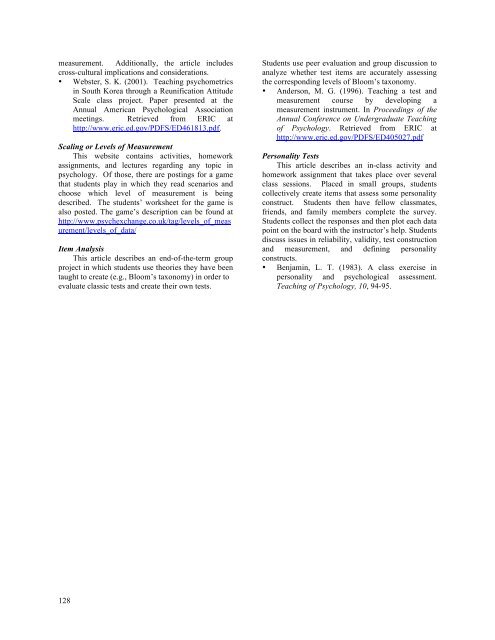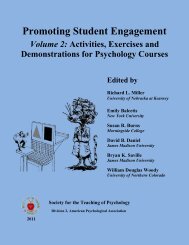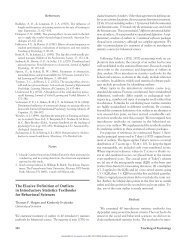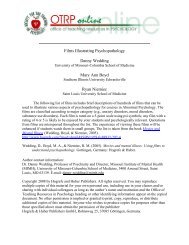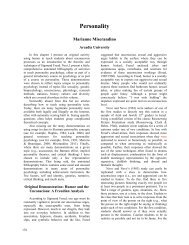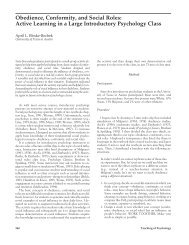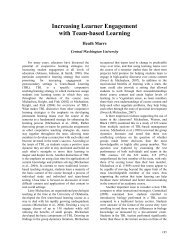Activities for Engagement in a Psychometric Course - Society for the ...
Activities for Engagement in a Psychometric Course - Society for the ...
Activities for Engagement in a Psychometric Course - Society for the ...
You also want an ePaper? Increase the reach of your titles
YUMPU automatically turns print PDFs into web optimized ePapers that Google loves.
measurement. Additionally, <strong>the</strong> article <strong>in</strong>cludes<br />
cross-cultural implications and considerations.<br />
• Webster, S. K. (2001). Teach<strong>in</strong>g psychometrics<br />
<strong>in</strong> South Korea through a Reunification Attitude<br />
Scale class project. Paper presented at <strong>the</strong><br />
Annual American Psychological Association<br />
meet<strong>in</strong>gs. Retrieved from ERIC at<br />
http://www.eric.ed.gov/PDFS/ED461813.pdf.<br />
Scal<strong>in</strong>g or Levels of Measurement<br />
This website conta<strong>in</strong>s activities, homework<br />
assignments, and lectures regard<strong>in</strong>g any topic <strong>in</strong><br />
psychology. Of those, <strong>the</strong>re are post<strong>in</strong>gs <strong>for</strong> a game<br />
that students play <strong>in</strong> which <strong>the</strong>y read scenarios and<br />
choose which level of measurement is be<strong>in</strong>g<br />
described. The students’ worksheet <strong>for</strong> <strong>the</strong> game is<br />
also posted. The game’s description can be found at<br />
http://www.psychexchange.co.uk/tag/levels_of_meas<br />
urement/levels_of_data/<br />
Item Analysis<br />
This article describes an end-of-<strong>the</strong>-term group<br />
project <strong>in</strong> which students use <strong>the</strong>ories <strong>the</strong>y have been<br />
taught to create (e.g., Bloom’s taxonomy) <strong>in</strong> order to<br />
evaluate classic tests and create <strong>the</strong>ir own tests.<br />
128<br />
Students use peer evaluation and group discussion to<br />
analyze whe<strong>the</strong>r test items are accurately assess<strong>in</strong>g<br />
<strong>the</strong> correspond<strong>in</strong>g levels of Bloom’s taxonomy.<br />
• Anderson, M. G. (1996). Teach<strong>in</strong>g a test and<br />
measurement course by develop<strong>in</strong>g a<br />
measurement <strong>in</strong>strument. In Proceed<strong>in</strong>gs of <strong>the</strong><br />
Annual Conference on Undergraduate Teach<strong>in</strong>g<br />
of Psychology. Retrieved from ERIC at<br />
http://www.eric.ed.gov/PDFS/ED405027.pdf<br />
Personality Tests<br />
This article describes an <strong>in</strong>-class activity and<br />
homework assignment that takes place over several<br />
class sessions. Placed <strong>in</strong> small groups, students<br />
collectively create items that assess some personality<br />
construct. Students <strong>the</strong>n have fellow classmates,<br />
friends, and family members complete <strong>the</strong> survey.<br />
Students collect <strong>the</strong> responses and <strong>the</strong>n plot each data<br />
po<strong>in</strong>t on <strong>the</strong> board with <strong>the</strong> <strong>in</strong>structor’s help. Students<br />
discuss issues <strong>in</strong> reliability, validity, test construction<br />
and measurement, and def<strong>in</strong><strong>in</strong>g personality<br />
constructs.<br />
• Benjam<strong>in</strong>, L. T. (1983). A class exercise <strong>in</strong><br />
personality and psychological assessment.<br />
Teach<strong>in</strong>g of Psychology, 10, 94-95.


